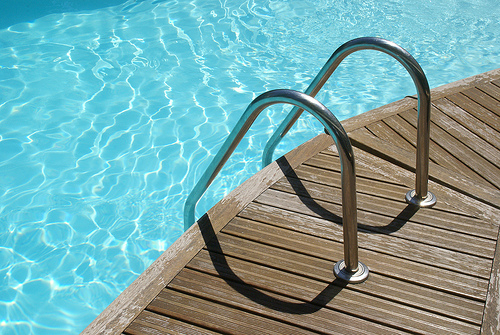 This summer it’s happened three times so far. Once, I got an urgent email from the backyard pool where they have baby swim lessons. Another time, my older son’s swim teacher pulled the class out of the high school pool and taught the kids “safety skills” on the deck. And when we were at camp, on the hottest day of the week, we peered through the chain link fence at a pool that was blue, inviting, and—because of recent events–empty.
This summer it’s happened three times so far. Once, I got an urgent email from the backyard pool where they have baby swim lessons. Another time, my older son’s swim teacher pulled the class out of the high school pool and taught the kids “safety skills” on the deck. And when we were at camp, on the hottest day of the week, we peered through the chain link fence at a pool that was blue, inviting, and—because of recent events–empty.
Call it whatever you want: a floater, a Baby Ruth, an “incident,” or just plain old poop in the pool. By any name, it’s probably there much more often than we think.
In a study released by the CDC this spring, researchers took 161 filter samples from Atlanta, Georgia-area public pools. Fifty-eight percent of the samples had E. coli—a marker for fecal contamination–in them, although none had E. coli O157:H7, which can actually make you sick. Less than two percent of samples had those other yuck-inducers, Cryptosporidium and Giardia.
It’s Cryptosporidium (and the loose stools that carry it) that people are the most concerned about when it comes to pools, says James Amburgey, an engineer at UNC Charlotte who studies drinking and recreational water treatment. Amburgey has looked at whether disposable swim diapers prevent the spread of Crypto (short answer: not really). Crypto is a parasite that’s resistant to chlorine; it can survive for a week or longer in a pool, and only opens up its cell wall once it reaches your intestines. While floaters are “disturbing,” he says, it’s unlikely that solid poop has Crypto.
 The CDC is putting together the Model Aquatic Health Code to address pool contamination and other pool-related health and safety issues. Right now, they recommend closing the pool and boosting the pool’s chlorine levels for designated periods of time depending on the fecal situation in question. Each of the pools that we’ve been to shut down for at least a day, sometimes more, although I’m not sure exactly what happened in each case. (I also learned this important, tangential piece of information in my research: there is no dye that shows that you peed in the pool—and if you do, the nitrogen in your pee can combine with chlorine to make an eye- and lung-irritating compound.)
The CDC is putting together the Model Aquatic Health Code to address pool contamination and other pool-related health and safety issues. Right now, they recommend closing the pool and boosting the pool’s chlorine levels for designated periods of time depending on the fecal situation in question. Each of the pools that we’ve been to shut down for at least a day, sometimes more, although I’m not sure exactly what happened in each case. (I also learned this important, tangential piece of information in my research: there is no dye that shows that you peed in the pool—and if you do, the nitrogen in your pee can combine with chlorine to make an eye- and lung-irritating compound.)
There are several things the CDC recommends for healthier pools: showering with soap before swimming, skipping the pool if you or your child feels sick, taking kids to the bathroom regularly during a swim session, washing your hands, keeping your mouth closed in the water.
Does all this make me too squeamish to dip my toes back in? You know, not really. Summer wouldn’t be the same for me without swimming pools. There’s nothing like that moment of mid-air suspension between hot pool deck and cool water. I’ll just try not to smile so wide.
**
Images from Flickr users Ian Britton (top) and John Welsh (middle)
Hahaha, the “dye that reveals your pee” story!
I was a lifeguard and that was a little lie we told kids to discourage them from peeing in the pool. Did it work? Who knows…
first sentence…
Oh dear, and did Richard put you up to this? Yes, my in-house copy editor was asleep, and I didn’t have the heart to wake him up, even to save me from myself.